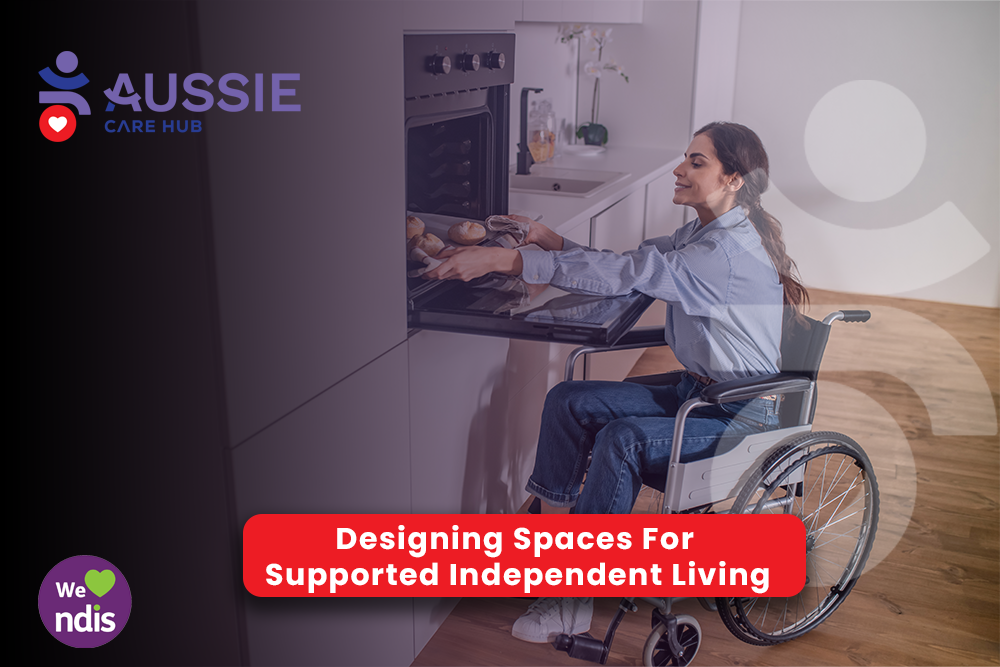Supported independent living is a concept that allows individuals with disabilities or age-related limitations to live more independently while still receiving necessary support and assistance. Creating spaces that are accessible and functional is crucial for promoting independence and enhancing overall quality of life.
1. Accessibility
Creating environments that are inclusive and accommodating to individuals with disabilities or age-related limitations is essential for promoting independence and improving overall quality of life. Here are some key considerations for ensuring accessibility in the design of such spaces:
· Physical Accessibility: One of the primary aspects of accessibility is ensuring physical accommodations for individuals with mobility challenges. This includes features like ramps, widened doorways, and stairlifts or elevators, if necessary. Well-placed handrails and grab bars in toilets and showers are also crucial for safety. By removing barriers and providing easy access to different areas of the living space, individuals can navigate their surroundings with greater ease and independence.
· Universal Design Principles: Universal design aims to make spaces user-friendly and inclusive for people of all abilities. This involves incorporating features that benefit everyone, such as low-pile carpeting or hardwood flooring for ease of movement, adjustable-height countertops and sinks, lever-style door handles, and easy-to-reach light switches and electrical outlets.
· Assistive Technology Integration: From voice-activated smart home devices to technology that controls lighting, temperature, and security
systems, these innovations empower individuals with disabilities to control their environment conveniently.
· Sensory Considerations: For individuals with sensory impairments, spaces should be designed to be sensitive to their needs. This may involve incorporating visual cues for individuals with hearing impairments, such as flashing lights for doorbells or fire alarms.
· Way-finding and Clear Signage: Implementing clear signage and wayfinding systems is essential for enabling individuals to navigate their living spaces independently. This includes using large, clear fonts with high contrast, ensuring signs are at eye level, and providing clear directions throughout the space.
2. Adaptive equipment:
Adaptive equipment refers to devices, tools, and modifications that enable individuals with disabilities or age-related limitations to perform daily tasks and activities with greater ease and independence.Here are some key considerations for integrating adaptive equipment in the design of such spaces:
· Wheelchair Accessibility: One of the primary considerations when it comes to adaptive equipment is ensuring wheelchair accessibility. This involves providing ramps or lifts for entryways, wide doorways and hallways for maneuverability, and spacious rooms and bathrooms that accommodate wheelchair turning radius.
· Bathroom Modifications: The bathroom is an essential area where adaptive equipment plays a crucial role. Grab bars strategically placed near toilets and showers provide stability and support for individuals with mobility challenges. Lever-style faucets are easier to operate for individuals with limited hand strength, and non-slip flooring reduces the risk of falls.
· Kitchen Adaptations: In the kitchen, adaptive equipment helps individuals with disabilities or difficulty in mobility to prepare meals and perform essential tasks. Adjustable countertops and sinks allow users to find a comfortable height for food preparation and clean-up. Pull-out drawers or shelves provide easy access to items, and non-slip mats keep utensils and appliances stable.
· Assistive Technology Integration: Adaptive equipment extends beyond physical modifications and can also include assistive technology. This technology enables individuals to control their environment and perform
tasks more independently. For example, voice-activated smart home devices can be integrated into living spaces, allowing individuals to control lighting, temperature, and appliances through voice commands.
· Adaptive Furniture and Bedding: Designing spaces for supported independent living should also consider adaptive furniture and bedding options. Adjustable beds and mattresses with pressure-relieving features can accommodate individuals with limited mobility or chronic pain. Lift chairs or recliners provide support and assistance when transitioning from sitting to standing positions.
3. Safety
Creating environments that are secure and conducive to the well-being of individuals with disabilities or age-related limitations is essential for their independence and overall quality of life. By considering and implementing safety measures, designers can ensure that these spaces promote a sense of security and enable residents to live with confidence. Here are some key considerations for ensuring safety in the design of supported independent living spaces:
· Fall Prevention: Falls are a significant concern for individuals with mobility challenges or balance issues. To prevent falls, designers should focus on creating barrier-free environments by minimizing tripping hazards, such as uneven flooring, thresholds, or loose rugs. Adequate lighting, both natural and artificial, is crucial to enhance visibility and reduce the risk of accidents.
· Fire Safety: Incorporating fire alarms, smoke detectors, and carbon monoxide detectors throughout the living space is essential. Ensuring easy access to fire extinguishers and clearly marked emergency exits are also important.
· Accessibility and Egress: Ensuring accessibility and egress are vital for safety in supported independent living spaces. Designers should provide wide doorways and hallways to accommodate the movement of mobility aids and equipment. Adequate turning radius for wheelchairs, smooth flooring surfaces, and properly designed ramps or lifts for accessibility are also crucial.
· Security Systems: Incorporating security systems is essential to provide a sense of safety and peace of mind. Designers should consider installing features such as surveillance cameras, video intercoms, and electronic access control systems. These systems not only contribute to the physical safety of residents but also provide an enhanced level of security by monitoring and controlling access to the living spaces.
· Bathroom Safety: Bathrooms can be particularly hazardous areas if not properly designed with safety in mind. Designers should incorporate non-slip flooring to reduce the risk of slips and falls when the floor is wet. Showers and tubs should have slip-resistant surfaces and be equipped with grab bars for stability.
· Emergency Response Systems: Implementing emergency response systems ensures that residents can receive prompt assistance in case of medical emergencies. Designers should consider integrating systems that allow residents to summon help, such as emergency call buttons or wearable panic pendants.
· Hazardous Material Precautions: Designers should also pay attention to potential hazards related to materials used in the living space. Ensuring that proper ventilation systems are in place, using non-toxic, environmentally friendly materials, and providing appropriate storage for cleaning supplies and chemicals are crucial considerations to prevent accidents or health issues.
4. Flexibility
Designing spaces that can adapt and accommodate changing needs and abilities is essential for ensuring the long-term comfort and well-being of individuals with disabilities or age-related limitations. By incorporating flexibility into the design process, designers can create spaces that are inclusive, empowering, and supportive. Here are some key considerations for incorporating flexibility in the design of supported independent living spaces:
· Modular and Adjustable Design: Designers should consider incorporating modular and adjustable elements into the living spaces. This allows for easy modifications and reconfigurations as needs change over time. Features like removable partition walls, adjustable countertops and shelves, and adaptable furniture provide the flexibility necessary to accommodate different physical abilities and preferences.
· Universal Design Principles: Universal design emphasizes the creation of spaces that are accessible and usable by people of all ages and abilities. By integrating universal design features such as wide doorways, zero-entry thresholds, lever-style door handles, and non-slip flooring, designers can ensure that the living spaces are adaptable and welcoming for everyone, regardless of their physical abilities or limitations.
· Accessible Storage Solutions: Storage is an important consideration in any living space. Designers should prioritize the integration of accessible
storage solutions that can be easily utilized by individuals with disabilities or limited mobility. Adjustable shelves, pull-down closet rods, and sliding or pull-out drawers are examples of storage options that provide flexibility and enhance accessibility.
· Multi-Purpose Rooms and Spaces: Incorporating multi-purpose rooms and spaces allows for flexibility in how the living space is utilized. For example, a room designed as a bedroom can also serve as a home office or a hobby room. By providing versatile spaces, residents have the freedom to adapt their living environment to suit their changing needs and interests. Designers should consider incorporating features such as built-in storage, foldable furniture, and movable partitions to maximize the versatility of these spaces.
· Technology Integration: Integrating technology can greatly enhance the flexibility of supported independent living spaces. Smart home automation systems, for instance, allow residents to control lighting, temperature, and security systems with ease. By utilizing voice-activated devices and programmable settings, residents can customize their living environment to accommodate their preferences and needs.
· Future-Proofing: Anticipating future needs and trends is an important aspect of designing flexible spaces. Designers should consider incorporating infrastructure and systems that can accommodate future advancements and adaptations. For example, installing wiring and outlets for future technology upgrades, or designing layouts that allow for potential accessibility modifications.
5. Privacy and autonomy
When designing spaces for supported independent living, privacy and autonomy are two fundamental aspects that should be carefully considered. It is crucial to create living environments that not only provide necessary support and assistance but also respect the individual’s need for privacy and autonomy. By prioritizing privacy and autonomy, designers can empower individuals with disabilities or age-related limitations, promoting their dignity, independence, and overall well-being. Here are some key considerations for incorporating privacy and autonomy in the design of supported independent living spaces
Personal Space: Designers should ensure that residents have adequate personal space within their living units. Each individual should have a private bedroom or a designated area that allows them personal time and the freedom to engage in activities without interruption. Providing separate spaces for relaxation, work, and personal care allows residents to maintain their privacy and dignity within their living environment.
· Accessible Privacy Features: Designers should consider elements like adjustable privacy screens, curtains, or blinds that can be easily operated by residents. Ensuring accessible window and door controls, such as lever-style handles or automated systems, allows residents to control their environment independently and maintain their privacy.
· Sound Insulation: To enhance privacy, designers should prioritize sound insulation within living units. Properly insulated walls, floors, and ceilings help minimize noise transmission between rooms and units. This is particularly important in shared living spaces, such as apartment-style environments, where residents should have the freedom to engage in activities and conversations without disturbing or being disturbed by neighbors.
· Functional Layout: The layout of the living space plays a crucial role in promoting privacy and autonomy. Designers should aim for a layout that provides clear separation between private and common areas. By strategically placing bedrooms, bathrooms, and living spaces, residents can have a sense of autonomy and control over their personal living areas while still having access to shared spaces for social interaction and community engagement.
· Assistive Technology Integration: Integrating assistive technology can significantly contribute to privacy and autonomy in supported independent living spaces. Smart home systems, for example, can allow residents to control various aspects of their environment, such as lighting, temperature, and security, through voice commands or mobile applications.
· Personalised Safety and Security Measures: Designers should consider incorporating personalized safety and security measures that respect the privacy of residents. For example, utilizing discreet and non-intrusive security systems, such as motion sensors or surveillance cameras with privacy masking, ensures that residents feel secure without compromising their privacy.
· Accessibility and Universal Design: Incorporating accessibility and universal design principles is essential for promoting privacy and autonomy. Designers should ensure that living spaces are easily navigable and allow individuals with disabilities to move freely and independently.
· Personal Assistive Technology Integration: In addition to general assistive technology, designers should also consider the integration of personal assistive devices and tools. Providing dedicated storage areas or charging
stations for assistive devices allows residents to keep their equipment close at hand and accessible whenever needed. This approach ensures that individuals have autonomy over their assistive devices and can use them in a way that suits their unique needs.

